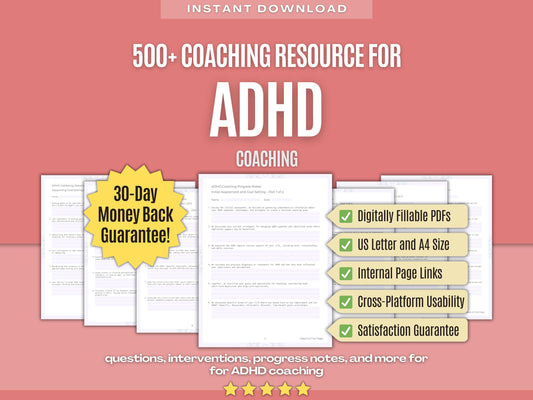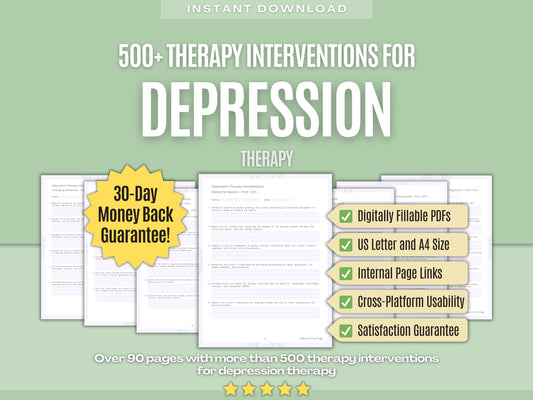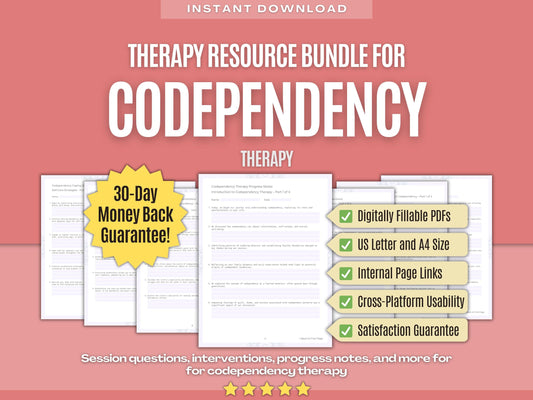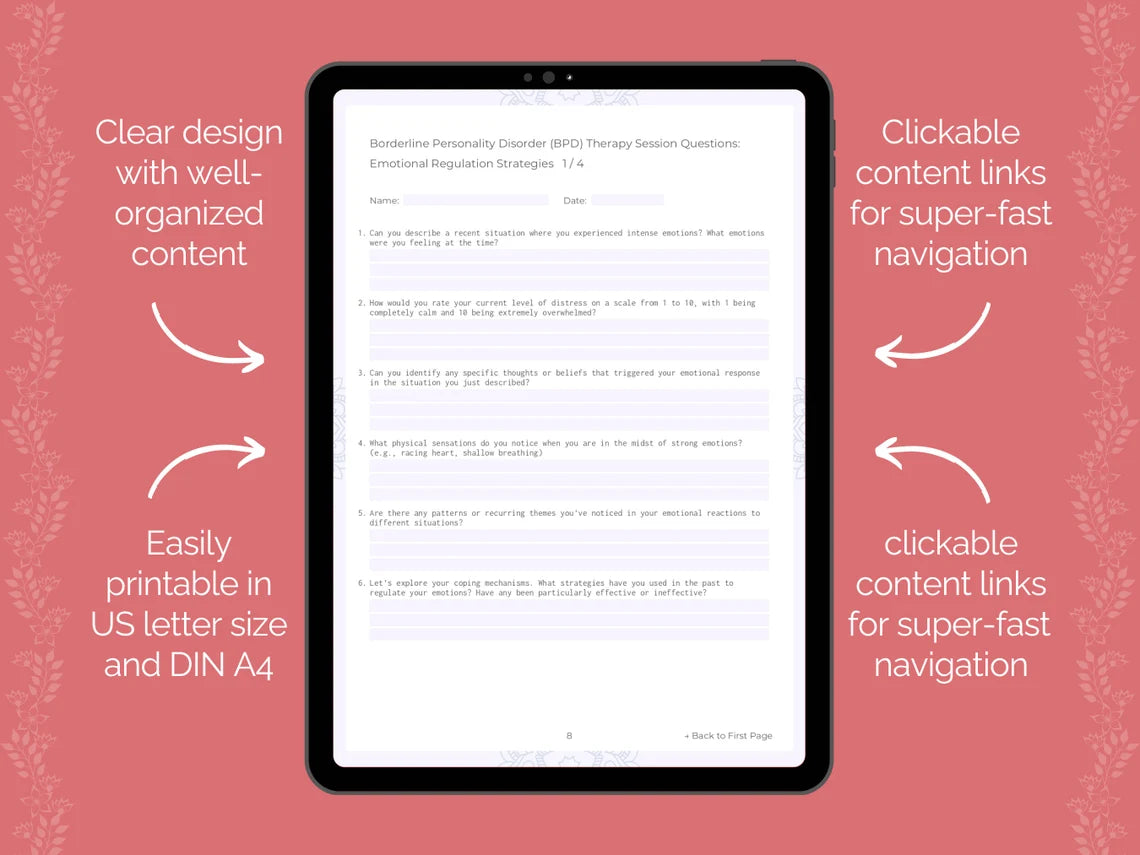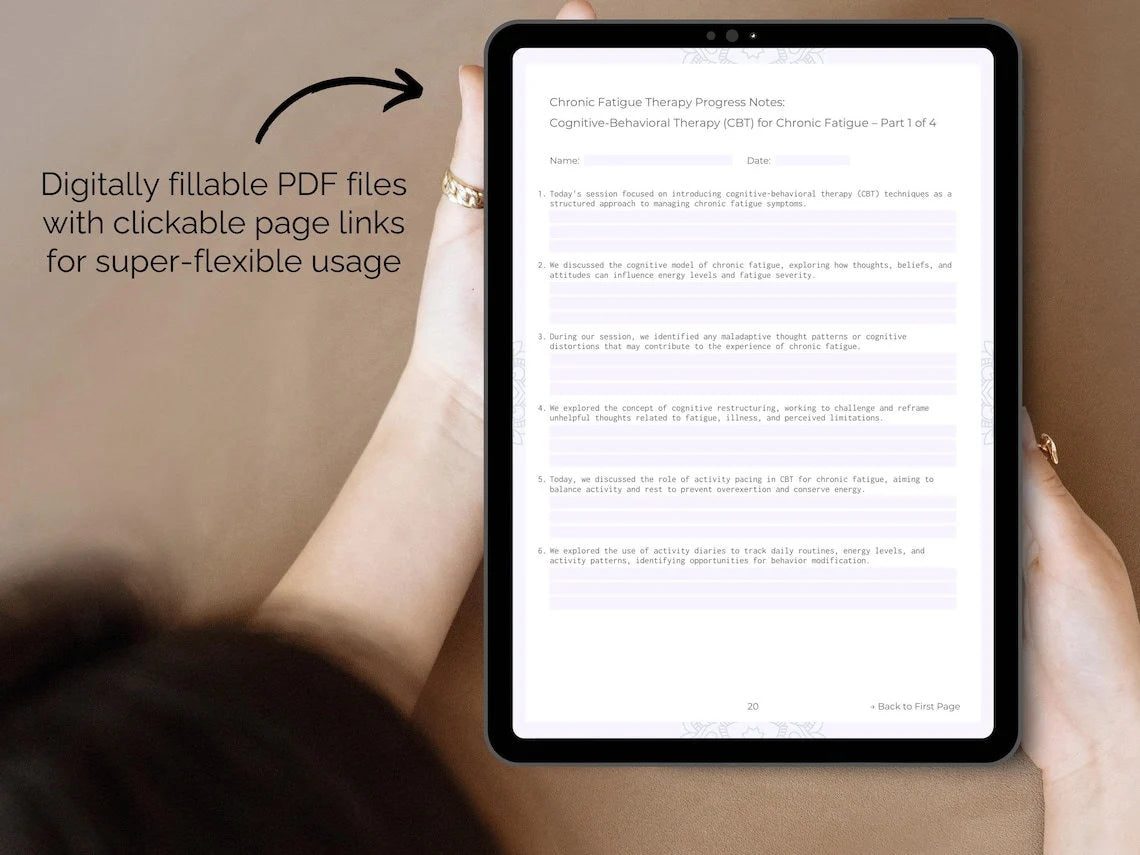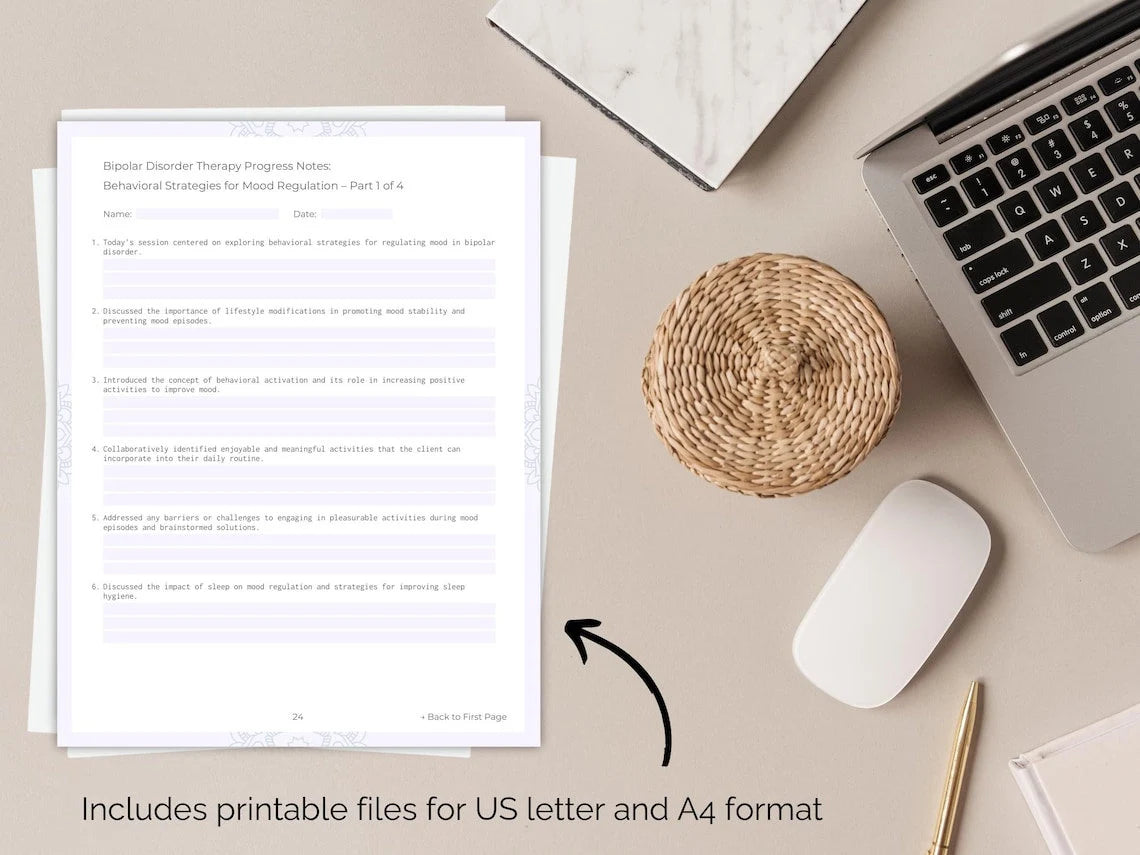Elevate Your Therapy and Guide Your Clients to Inner Healing with Our Anorexia Therapy Interventions! ✨
1. Beginning Anorexia Therapy
- Start by establishing a therapeutic alliance with the client, emphasizing empathy, understanding, and a nonjudgmental stance to create a safe space for exploration and growth.
- Collaboratively set treatment goals with the client, ensuring they align with their values, priorities, and desired outcomes for recovery.
- Explore the client's personal experiences with anorexia, including their thoughts, feelings, behaviors, and any underlying factors contributing to the development or maintenance of the disorder.
- Normalize the client's experiences and emotions, validating their struggles while instilling hope for recovery and highlighting the possibility of positive change.
- Explore the client's relationship with food, including their beliefs, attitudes, rituals, and behaviors surrounding eating, to identify areas for intervention and support.
- Introduce behavioral interventions to address maladaptive eating behaviors, such as food restriction, bingeing, purging, or excessive exercise, through techniques such as self-monitoring, meal planning, and exposure therapy.
- Address any co-occurring mental health conditions, such as depression, anxiety, trauma, or substance abuse, through integrated treatment approaches and referrals to specialized providers if necessary.
- Introduce mindfulness-based techniques to help the client develop present-moment awareness, self-regulation, and acceptance of internal experiences, such as hunger cues, emotions, and body sensations.
- Collaborate with the client to identify and challenge maladaptive coping mechanisms, such as perfectionism, people-pleasing, avoidance, or self-criticism, that may contribute to their eating disorder.
- Introduce techniques for improving body image and self-esteem, such as body positivity exercises, mirror exposure, and cognitive restructuring of negative self-talk.
- Collaboratively develop a relapse prevention plan with the client, identifying early warning signs, coping strategies, social supports, and resources to mitigate the risk of relapse and maintain recovery gains.
Need more? Find all 500+ Therapy Interventions for Anorexia Therapy in our Digital Workbook!
2. Anorexia Psychoeducation
- Begin by explaining the clinical definition of anorexia nervosa, emphasizing that it is a serious mental health condition characterized by extreme weight loss, fear of gaining weight, and a distorted body image.
- Explain the diagnostic criteria for anorexia nervosa as outlined in the Diagnostic and Statistical Manual of Mental Disorders (DSM-5), including criteria related to weight loss, restrictive eating behaviors, intense fear of gaining weight, and disturbances in body image.
- Explore the psychological and emotional consequences of anorexia nervosa, including symptoms of depression, anxiety, obsessive-compulsive behaviors, social withdrawal, and impaired cognitive functioning.
- Address common myths and misconceptions about anorexia nervosa, such as the belief that it is solely about vanity or attention-seeking behavior, and provide accurate information to dispel stigma and promote understanding.
- Explore the potential function and meaning of anorexic behaviors for the individual, considering factors such as coping mechanisms, control issues, identity formation, interpersonal dynamics, and emotional regulation.
- Discuss the course and prognosis of anorexia nervosa, highlighting that recovery is possible with appropriate treatment and support but may involve periods of relapse, remission, and ongoing management.
- Explain the principles of evidence-based treatment approaches for anorexia nervosa, such as cognitive-behavioral therapy (CBT), family-based treatment (FBT), dialectical behavior therapy (DBT), and nutritional counseling, highlighting their effectiveness and recommended use.
- Provide resources and referrals for additional support, such as eating disorder treatment centers, support groups, online forums, helplines, and self-help books, to empower the client in their recovery journey.
- Explore the stigma and discrimination faced by individuals with anorexia nervosa, including challenges related to accessing healthcare, seeking employment, forming relationships, and participating in society.
- Discuss the cultural and societal factors that influence attitudes towards body image, weight, food, and eating disorders, recognizing the importance of cultural sensitivity and inclusivity in treatment.
- Provide psychoeducation about the recovery process from anorexia nervosa, emphasizing that it is a gradual and nonlinear journey characterized by ups and downs, setbacks, and successes.
Need more? Find all 500+ Therapy Interventions for Anorexia Therapy in our Digital Workbook!
3. Mindfulness for Eating Disorders
- Begin by introducing the concept of mindfulness as a therapeutic approach for managing eating disorders, explaining that mindfulness involves paying attention to the present moment with openness, curiosity, and acceptance.
- Explore the role of mindfulness in promoting self-regulation and self-awareness, emphasizing its potential to interrupt automatic or habitual patterns of thought and behavior associated with disordered eating.
- Guide the client through mindfulness exercises focused on sensory awareness, encouraging them to notice the colors, textures, smells, tastes, and sounds associated with food without judgment or attachment.
- Explore the concept of urge surfing, a mindfulness-based technique for coping with food cravings or urges to engage in disordered eating behaviors, by encouraging the client to observe and ride out the wave of discomfort without acting impulsively.
- Discuss the potential benefits of incorporating mindfulness into daily life routines, such as during meal times, self-care activities, exercise, social interactions, and moments of stress or challenge.
- Foster self-compassion and acceptance as integral components of mindfulness practice, encouraging the client to cultivate kindness, gentleness, and nonjudgment towards themselves as they navigate the ups and downs of recovery.
- Explore the relationship between mindfulness and emotional regulation, highlighting how mindfulness practices can help individuals recognize and respond to difficult emotions with greater clarity, resilience, and equanimity.
- Explore the concept of nonattachment in mindfulness practice, encouraging the client to observe their thoughts, emotions, and cravings without getting caught up or identified with them, fostering a sense of freedom and detachment.
- Guide the client in developing a personalized mindfulness routine or practice plan, incorporating a variety of mindfulness exercises and techniques tailored to their preferences, needs, and lifestyle.
- Address the role of mindfulness in promoting body acceptance and appreciation, encouraging the client to shift their focus from external appearance to internal sensations, experiences, and qualities.
- Discuss the research evidence supporting the effectiveness of mindfulness-based interventions for eating disorders, highlighting their potential to reduce symptoms, improve quality of life, and support long-term recovery.
Need more? Find all 500+ Therapy Interventions for Anorexia Therapy in our Digital Workbook!
4. Dialectical Behavior Therapy (DBT) for Emotional Regulation
- Begin by introducing the core principles of Dialectical Behavior Therapy (DBT), emphasizing the dialectical nature of balancing acceptance and change in the treatment of anorexia nervosa.
- Collaboratively identify the client's specific emotional triggers and vulnerabilities, exploring the antecedents and consequences of emotional dysregulation in their daily life.
- Guide the client in practicing mindfulness exercises focused on observing and describing emotions, thoughts, bodily sensations, and environmental stimuli without reacting impulsively or judgmentally.
- Address common barriers to emotional regulation, such as avoidance, suppression, rumination, or invalidation, using cognitive-behavioral techniques to challenge maladaptive coping strategies and promote adaptive responses.
- Introduce distress tolerance skills training to help the client cope with intense emotions and crises without resorting to harmful or impulsive behaviors, such as self-harm or substance abuse.
- Introduce interpersonal effectiveness skills training to help the client navigate challenging relationships and communication patterns, using assertiveness, boundaries, and conflict resolution techniques to improve interpersonal interactions.
- Address any difficulties or challenges related to emotion expression, such as alexithymia, social inhibition, or fear of vulnerability, using experiential techniques to enhance emotional awareness and expression.
- Address any difficulties or challenges related to self-soothing and self-care, using relaxation techniques, sensory grounding exercises, and pleasurable activities to promote emotional well-being and resilience.
- Foster self-compassion and acceptance as integral components of emotional regulation, encouraging the client to approach themselves with kindness, understanding, and forgiveness as they navigate the ups and downs of recovery.
- Address any difficulties or challenges related to emotional regulation in specific contexts or domains of life, such as school, work, relationships, or social situations, using problem-solving skills training to develop adaptive coping strategies.
- Collaboratively develop a personalized emotion regulation toolkit with the client, identifying effective coping strategies, relaxation techniques, and resources to use in moments of distress or crisis.
Need more? Find all 500+ Therapy Interventions for Anorexia Therapy in our Digital Workbook!
5. Interpersonal Therapy (IPT) for Relationship Issues
- Begin by introducing the core principles of Interpersonal Therapy (IPT), which focuses on exploring the client's interpersonal relationships and their impact on the development and maintenance of anorexia nervosa.
- Collaboratively identify the client's interpersonal problem areas, such as unresolved grief, role transitions, interpersonal disputes, or social isolation, that may contribute to their eating disorder symptoms.
- Address any unresolved grief or loss experiences that may contribute to the client's eating disorder symptoms, using grief-focused interventions to process and integrate feelings of loss and sadness.
- Address any interpersonal disputes or conflicts that may contribute to the client's eating disorder symptoms, using communication skills training and conflict resolution techniques to improve assertiveness, empathy, and problem-solving.
- Address any difficulties or challenges related to social isolation or loneliness, using social skills training and behavioral activation techniques to increase social engagement and connection.
- Collaboratively develop interpersonal goals with the client, focusing on improving communication, assertiveness, intimacy, and conflict resolution skills in their relationships.
- Introduce the concept of "interpersonal deficits" in IPT, which refers to longstanding difficulties in establishing and maintaining relationships, using role-playing and behavioral experiments to practice new interpersonal skills and behaviors.
- Address any difficulties or challenges related to boundary-setting and assertiveness, using IPT techniques to clarify personal boundaries, express needs and preferences, and negotiate interpersonal boundaries in relationships.
- Introduce the concept of "interpersonal sensitivity" in IPT, which refers to the client's heightened awareness and responsiveness to interpersonal cues and dynamics, using mindfulness-based techniques to regulate emotional reactivity and enhance empathy.
- Explore the client's family dynamics and relational patterns, using systemic and relational techniques to identify how family dynamics may contribute to the maintenance of their eating disorder.
- Address any difficulties or challenges related to expressing emotions or seeking support from others, using emotion-focused interventions and attachment-based techniques to enhance emotional expression and interpersonal connection.
Need more? Find all 500+ Therapy Interventions for Anorexia Therapy in our Digital Workbook!
6. Emotion-Focused Therapy (EFT) for Anorexia
- Begin by introducing the core principles of Emotion-Focused Therapy (EFT), which emphasizes the importance of accessing and processing emotions as a central aspect of healing from anorexia nervosa.
- Collaboratively establish therapeutic goals with the client, focusing on increasing emotional awareness, regulation, and processing as key components of their recovery journey.
- Encourage the client to explore the underlying emotions that drive their eating disorder behaviors, helping them identify and label their emotions accurately and develop a deeper understanding of their emotional triggers and vulnerabilities.
- Explore the function and meaning of the client's emotions within the context of their eating disorder, helping them recognize how their emotions serve as signals of unmet needs, conflicts, or relational dynamics.
- Foster a compassionate and accepting stance towards the client's emotions, validating their experiences and helping them develop self-compassion and acceptance towards their emotional struggles.
- Facilitate emotion-focused interventions to help the client regulate and tolerate distressing emotions, such as deep breathing, progressive muscle relaxation, or mindfulness-based techniques.
- Facilitate emotion-focused interventions to help the client process unresolved emotions or traumas that may be contributing to their eating disorder symptoms, using techniques such as imagery rescripting or emotion-focused writing.
- Encourage the client to identify and express their emotional needs in relationships, helping them develop assertiveness and boundary-setting skills to communicate their needs effectively.
- Foster emotion-focused self-reflection and insight, helping the client recognize patterns, themes, and underlying meanings in their emotional experiences and eating disorder behaviors.
- Explore the client's emotional schemas or core beliefs about themselves, others, and the world, helping them identify and challenge maladaptive beliefs that contribute to their emotional distress and eating disorder symptoms.
- Encourage the client to explore the connection between their emotions and their eating disorder behaviors, helping them recognize how their emotions may influence their appetite, food choices, and body image perceptions.
Need more? Find all 500+ Therapy Interventions for Anorexia Therapy in our Digital Workbook!
7. Psychodynamic Approaches to Eating Disorders
- Encourage exploration of early childhood experiences and relationships to uncover unconscious conflicts and patterns contributing to disordered eating behaviors.
- Facilitate exploration of underlying emotional needs and vulnerabilities that may be masked by disordered eating behaviors.
- Explore the role of attachment styles and interpersonal relationships in the development and maintenance of disordered eating behaviors.
- Facilitate exploration of unconscious conflicts, fears, and anxieties that may be driving disordered eating behaviors.
- Explore the client's relationship with authority figures and how it may influence their relationship with food and body image.
- Explore the client's feelings of identity, self-worth, and agency within the context of their eating disorder.
- Facilitate exploration of ambivalent feelings towards independence, autonomy, and dependency within the context of the eating disorder.
- Examine the role of perfectionism and the pursuit of an idealized self-image in maintaining disordered eating behaviors.
- Explore the client's emotional relationship with food and how it reflects deeper emotional needs and conflicts.
- Use ego psychology to strengthen the client's sense of self and ability to tolerate uncomfortable emotions without resorting to maladaptive coping mechanisms.
- Encourage the expression of anger, resentment, or other suppressed emotions that may be contributing to the eating disorder.
Need more? Find all 500+ Therapy Interventions for Anorexia Therapy in our Digital Workbook!
8. Music Therapy for Emotional Healing
- Begin sessions with grounding exercises such as deep breathing or body scans to help clients become present and centered before engaging in music therapy activities.
- Incorporate guided imagery and visualization techniques, using music to enhance clients' ability to imagine themselves in peaceful and healing environments.
- Explore the use of songwriting as a tool for expression and reflection, helping clients articulate their thoughts and feelings through lyrics and melody.
- Integrate relaxation techniques such as progressive muscle relaxation or guided meditation with music therapy to help clients reduce stress and anxiety.
- Use guided music listening exercises to help clients access and process difficult emotions in a safe and supportive way.
- Explore the use of music as a way to regulate emotions and promote emotional self-awareness, helping clients identify and cope with their feelings more effectively.
- Use guided music improvisation exercises to help clients explore and express complex emotions that may be difficult to articulate verbally.
- Explore the use of music as a form of self-care, helping clients identify ways to incorporate music into their daily lives to support their emotional well-being.
- Use music as a tool for building emotional resilience and coping skills, helping clients develop strategies for managing stress, anxiety, and other difficult emotions.
- Explore the use of music as a way to access and process memories and experiences that may be difficult to access through verbal communication alone.
- Use music as a way to promote self-expression and empowerment, helping clients find their voice and assert their needs and boundaries.
Need more? Find all 500+ Therapy Interventions for Anorexia Therapy in our Digital Workbook!
9. Wrapping Up Therapy Sessions
- Review the key insights, goals, and progress made during the therapy session to reinforce learning and provide closure.
- Summarize the main themes and topics discussed during the session, highlighting important moments of insight or growth.
- Offer validation and empathy for any difficult emotions or challenges clients may have encountered during the session, creating a supportive space for processing.
- Provide psychoeducation or resources related to the topics discussed during the session, empowering clients with knowledge and tools to support their ongoing recovery.
- Validate clients' efforts and strengths, recognizing the courage and resilience it takes to engage in therapy and work towards recovery.
- Offer encouragement and praise for clients' willingness to engage in therapy and explore difficult emotions and experiences.
- Collaboratively explore any resistance or ambivalence clients may be experiencing towards therapy or their recovery journey, working together to address underlying concerns.
- Discuss potential strategies for maintaining progress and coping with challenges after therapy has ended, providing clients with tools and resources for ongoing support.
- Review any important information or insights that emerged during the session, ensuring that clients feel heard and understood.
- Explore any unresolved issues or concerns that may need further attention in future sessions or referrals to other professionals.
- Offer reassurance and support for clients' ongoing journey towards recovery, reminding them that they are not alone and that help is available.
Need more? Find all 500+ Therapy Interventions for Anorexia Therapy in our Digital Workbook!
10. Reflecting on Anorexia Therapy Journey
- Begin by inviting clients to reflect on their overall therapy journey, encouraging them to consider how far they have come since the beginning of treatment.
- Facilitate a discussion about the goals clients initially set for themselves at the start of therapy, encouraging them to reflect on which goals they have achieved and which ones may still be in progress.
- Encourage clients to reflect on the changes they have noticed in themselves since starting therapy, both internally (e.g., shifts in thoughts, feelings, beliefs) and externally (e.g., changes in behaviors, relationships).
- Validate clients' efforts and progress, acknowledging the courage and resilience it takes to confront and overcome challenges associated with anorexia.
- Facilitate a discussion about the therapeutic relationship, inviting clients to share their thoughts and feelings about their interactions with the therapist and how these interactions impacted their therapy journey.
- Explore the impact of social support and relationships on clients' recovery journey, helping them identify sources of support and connection that have been helpful to them.
- Invite clients to explore any fears or anxieties they may have about ending therapy, reassuring them that they have developed the skills and resources necessary to continue their recovery journey independently.
- Encourage clients to reflect on their values and priorities, helping them identify what is truly important to them and how they can align their actions with their values in their ongoing recovery journey.
- Use mindfulness or grounding techniques to help clients stay present and connected as they reflect on their therapy journey, supporting them in processing difficult emotions or memories that may arise.
- Explore the role of self-compassion and acceptance in clients' recovery journey, helping them cultivate a sense of kindness and understanding towards themselves.
- Encourage clients to celebrate their achievements and milestones, recognizing the progress they have made and the resilience they have demonstrated in their recovery journey.
We hope that our therapy interventions for Anorexia therapy will help you to elevate your therapy practice and guide your clients to inner healing! Do you need more therapy interventions for Anorexia therapy? Find them all in our Digital Workbook! Or do you have any questions or suggestions for us? Please feel free to contact us at any time!


